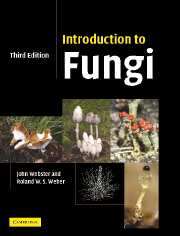Book contents
- Frontmatter
- Contents
- Preface to the first edition
- Preface to the second edition
- Preface to the third edition
- Acknowledgements
- 1 Introduction
- 2 Protozoa: Myxomycota (slime moulds)
- 3 Protozoa: Plasmodiophoromycota
- 4 Straminipila: minor fungal phyla
- 5 Straminipila: Oomycota
- 6 Chytridiomycota
- 7 Zygomycota
- 8 Ascomycota (ascomycetes)
- 9 Archiascomycetes
- 10 Hemiascomycetes
- 11 Plectomycetes
- 12 Hymenoascomycetes: Pyrenomycetes
- 13 Hymenoascomycetes: Erysiphales
- 14 Hymenoascomycetes: Pezizales (operculate discomycetes)
- 15 Hymenoascomycetes: Helotiales (inoperculate discomycetes)
- 16 Lichenized fungi (chiefly Hymenoascomycetes: Lecanorales)
- 17 Loculoascomycetes
- 18 Basidiomycota
- 19 Homobasidiomycetes
- 20 Homobasidiomycetes: gasteromycetes
- 21 Heterobasidiomycetes
- 22 Urediniomycetes: Uredinales (rust fungi)
- 23 Ustilaginomycetes: smut fungi and their allies
- 24 Basidiomycete yeasts
- 25 Anamorphic fungi (nematophagous and aquatic forms)
- References
- Index
- Plate section
Preface to the first edition
- Frontmatter
- Contents
- Preface to the first edition
- Preface to the second edition
- Preface to the third edition
- Acknowledgements
- 1 Introduction
- 2 Protozoa: Myxomycota (slime moulds)
- 3 Protozoa: Plasmodiophoromycota
- 4 Straminipila: minor fungal phyla
- 5 Straminipila: Oomycota
- 6 Chytridiomycota
- 7 Zygomycota
- 8 Ascomycota (ascomycetes)
- 9 Archiascomycetes
- 10 Hemiascomycetes
- 11 Plectomycetes
- 12 Hymenoascomycetes: Pyrenomycetes
- 13 Hymenoascomycetes: Erysiphales
- 14 Hymenoascomycetes: Pezizales (operculate discomycetes)
- 15 Hymenoascomycetes: Helotiales (inoperculate discomycetes)
- 16 Lichenized fungi (chiefly Hymenoascomycetes: Lecanorales)
- 17 Loculoascomycetes
- 18 Basidiomycota
- 19 Homobasidiomycetes
- 20 Homobasidiomycetes: gasteromycetes
- 21 Heterobasidiomycetes
- 22 Urediniomycetes: Uredinales (rust fungi)
- 23 Ustilaginomycetes: smut fungi and their allies
- 24 Basidiomycete yeasts
- 25 Anamorphic fungi (nematophagous and aquatic forms)
- References
- Index
- Plate section
Summary
There are several available good textbooks of mycology, and some justification is needed for publishing another. I have long been convinced that the best way to teach mycology, and indeed all biology, is to make use, wherever possible, of living material. Fortunately with fungi, provided one chooses the right time of the year, a wealth of material is readily available. Also by use of cultures and by infecting material of plant pathogens in the glasshouse or by maintaining pathological plots in the garden, it is possible to produce material at almost any time. I have therefore tried to write an introduction to fungi which are easily available in the living state, and have tried to give some indication of where they can be obtained. In this way I hope to encourage students to go into the field and look for fungi themselves. The best way to begin is to go with an expert, or to attend a Fungus Foray such as those organized in the spring and autumn by mycological and biological societies. I owe much of my own mycological education to such friendly gatherings. A second aim has been to produce original illustrations of the kind that a student could make for himself from simple preparations of living material, and to illustrate things which he can verify for himself. For this reason I have chosen not to use electron micrographs, but to make drawings based on them.
Information
- Type
- Chapter
- Information
- Introduction to Fungi , pp. xiii - xivPublisher: Cambridge University PressPrint publication year: 2007
